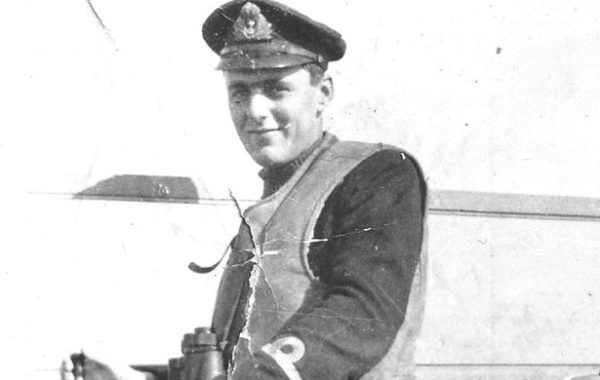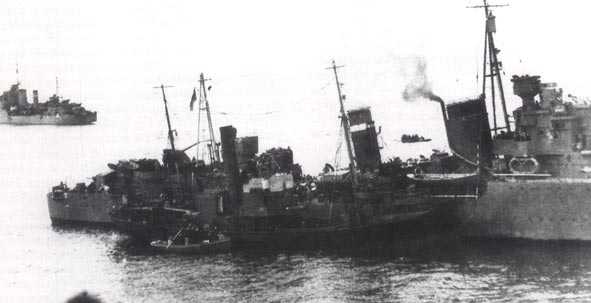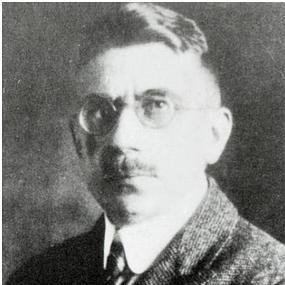Nearly two years after the start of World War II, the British Royal Navy for the first time put a boarding party onto a crippled German submarine. On May 9, 1942, 20-year-old sub-lieutenant David Balme led a party of nine sailors onto U-110, not knowing if the boat had been booby-trapped and half expecting scuttling charges to detonate at any moment.
Balme and his men had been sent across from H.M.S. Bulldog by her captain, Commander Joe Baker-Cresswell, with orders to gather up signal books and any other useful materials they might find (see blog post “Lemp’s Fatal Mistake, Aug. 30, 2018). Balme was the first man into the submarine, and when he was certain the boat had been abandoned, he called for the rest of the men to join him in the U-boat’s control room.
“The lights were still on and everything was lying about just as if one had arrived at someone’s house after breakfast, before they had had time to make beds, etc., coats were thrown around, bunks half made,” he later remembered. “There was complete silence in the U-boat except for the continual thud of our own depth charges [in pursuit of a second U-boat]…a most unpleasant and frightening noise.”
He told the men to ignore anything that was obviously casual reading material and to take whatever else appeared to be of interest. Speed was of the essence because U-110 was sinking and Balme was still concerned about explosive charges. Complicating matters was the fact that none of the men read German.
At one point, a sailor came out of the U-boat’s radio room and told Balme, “There’s something rather interesting I want to show you.” In the cramped radio room, Balme was shown a typewriter-like device screwed to the table. He could see that pressing one key on the machine caused a different letter to light up on a display. Balme told the sailor to unscrew it and send it up with the rest of the material being gathered. The young sub-lieutenant had no way of knowing that his party had just recovered the first working model of the German naval Enigma machine, a top-secret prize British Intelligence had coveted since the start of the war.
As the day wore on and the submarine remained afloat, Balme became less concerned about scuttling charges or the boat’s quick demise. At one point, Bulldog sent over sandwiches and a small boat to replace the one that had smashed itself on the U-110’s deck. He did worry, however, when Bulldog was called away on a U-boat sighting and a dense fog settled on the ocean.
“There was I, with my boarding party aboard U-110 in the middle of the Atlantic, alone with no ships in sight and with the wind and sea gradually increasing,” Balme recalled. Fortunately, Baker-Cresswell’s dead-reckoning navigation skills brought Bulldog back to the crippled submarine before nightfall, and the treasure trove of materials, including the Enigma machine and its codebooks, were transferred to the British destroyer.
By day’s end, Bulldog took U-110 under tow in hopes of delivering her to Iceland for careful inspection by British submarine experts. The next day, however, the U-boat sank en route. By then, the submarine’s capture and its trove of materials had been given a top-secret designation with the code name “Primrose.” Great effort went into limiting the number of people made aware of Primrose, and the capture was kept secret for several decades after the war.
U-110’s sinking may have been a blessing in disguise. Had the boat been towed to Iceland, it is entirely possible that local German spies would have relayed its capture to German authorities. German naval commanders would have assumed their encrypted communications could be compromised and they would have made changes to the Enigma machine and its codes much sooner than was actually the case. Even after the Germans made modifications in an effort to restore the naval Enigma’s integrity, insights gained by British intelligence from the materials taken from U-110 helped reduce code-breaking to a matter of hours or days instead or weeks.
At least one naval historian went so far as to characterize Operation Primrose on a scale commensurate with the outcomes of the Battle of Midway in the Pacific and the Battle of Stalingrad in Europe – not a bad day’s work for a Royal Navy convoy escort group and a junior naval officer barely out of his teens.




